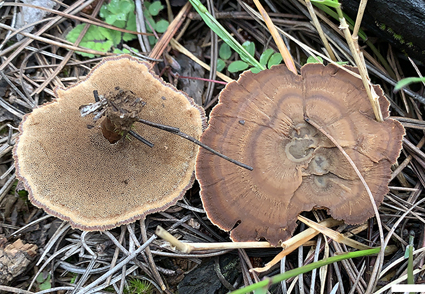Abstract
A new polypore in the family Hymenochaetaceae, Coltricia aridicola, is described and illustrated from China and the USA based on morphology and phylogenetic analysis. The species was found in northeast and southwest China and western USA, growing on soil in gymnosperm forests. It is characterized by an annual growth habit, centrally stipitate basidiocarps with regular pilei, pileal surface distinctly zonate, medium-sized pores as 3–4 per mm, a monomitic hyphal system, generative hyphae with simple septa, the presence of antler-like hyphal elements at the pileal surface, contextual hyphae almost twice the diameter of the tramal hyphae, thick-walled, yellowish, cyanophilous, oblong-ellipsoid basidiospores measuring 7–7.8 × 4.5–4.8 µm, and growth in dry environments such as burnt soil or open areas of ground in gymnosperm forests. The phylogenetic analysis based on ITS sequences showed that samples of C. aridicola nested in Coltricia, forming a monophyletic lineage with strong support (100 % BS, 100 % BP, 1.00 BPP). The differences between C. aridicola and its similar and related species in the genus are discussed.
References
- Anonymous (1969) Flora of British fungi. Colour identification chart. Her Majesty’s Stationery Office, London.
- Bian, L.S., Zhou, M. & Yu, J. (2022) Three new Coltricia (Hymenochaetaceae, Basidiomycota) species from China based on morphological characters and molecular evidence. Mycological progress 21: 45. https://doi.org/10.1007/s11557-022-01792-2
- Corner, E.J.H. (1991) Ad Polyporaceas VII. Beihefte zur Nova Hedwigia 101: 1–175.
- Dai, Y.C. (2010) Hymenochaetaceae (Basidiomycota) in China. Fungal Diversity 45: 131–343. https://doi.org/10.1007/s13225-010-0066-9
- Dai, Y.C. (2012) Polypore diversity in China with an annotated checklist of Chinese polypores. Mycoscience 53: 49–80. https://doi.org/10.1007/s10267-011-0134-3
- Donk, M.A. (1974) Check list of European polypores. Verh Koninkl Nederl Akad Wet, Natuurk 62: 1–469.
- Felsenstein, J. (1985) Confidence intervals on phylogenetics: an approach using bootstrap. Evolution 39: 783–791. https://doi.org/10.2307/2408678
- Gilbertson, R.L. & Ryvarden, L. (1986) North American polypores 1. Abortiporus - Lindtneria. Fungiflora, Oslo, pp. 1–433.
- Hall, T.A. (1999) Bioedit: a user-friendly biological sequence alignment editor and analysis program for windows 95/98/NT. Nucleic Acids Symposium Series 41: 95–98.
- Hillis, D.M. & Bull, J.J. (1993) An empirical test of bootstrapping as a method for assessing confidence in phylogenetic analysis. Systematic Biology 42: 182–192. https://doi.org/10.2307/2992540
- Ji, X.H., Vlasák, J., Zhou, L.W., Wu, F. & Dai, Y.C. (2017) Phylogeny and diversity of Fomitiporella (Hymenochaetales, Basidiomycota). Mycologia 109 (2): 308–322. https://doi.org/10.1080/00275514.2017.1305943
- Katoh, K. & Toh, H. (2008) Improved accuracy of multiple ncRNA alignment by incorporating structural information into a MAFFT-based framework. BMC Bioinformatics 9: 212. https://doi.org/10.1186/1471-2105-9-212
- Keizer, P.J. (1997) Coltricia confluens: A new polypore from the Netherlands. Persoonia 16 (3): 389–391.
- Linnaeus, C. (1753) Species Plantarum 2: 561–1200.
- Lloyd, C.G. (1908) Polyporoid Issue. Mycological notes 3: 1–16.
- Murrill, W.A. (1903) A historical review of the genera of the Polyporaceae. Journal of Mycology 9 (2): 87–102. https://doi.org/10.2307/3752511
- Núñez, M. & Ryvarden, L. (2000) East Asian polypores 1. Ganodermataceae and Hymenochaetaceae. Synopsis Fungorum 13: 1–168.
- Peck, C.H. (1879) Report of the Botanist. Annual Report on the New York State Museum of Natural History 32: 17–72.
- Petersen, J.H. (1996) Farvekort. Foreningen til Svampekundskabens Fremme. Foreningen til Svampekundskabens Fremme, Greve.
- Posada, D. & Crandall, K.A. (1998) Modeltest: testing the model of DNA substitution. Bioinformatics 14: 817–818. https://doi.org/10.1093/bioinformatics/14.9.817
- Ronquist, F. & Huelsenbeck, J.P. (2003) MRBAYES 3: Bayesian phylogenetic inference under mixed models. Bioinformatics 19: 1572–1574. https://doi.org/10.1093/bioinformatics/btg180
- Ryvarden, L. & Melo, I. (2017) Poroid fungi of Europe, 2nd edition. Synopsis Fungorum 37: 1–431.
- Stamatakis, A. (2006) RAxML-VI-HPC: maximum likelihood-based phylogenetic analyses with thousands of taxa and mixed models. Bioinformatics 22: 2688–2690. https://doi.org/10.1093/bioinformatics/btl446
- Swofford, D.L. (2002) PAUP*: phylogenetic analysis using parsimony (*and other methods), version 4.0b10. Sinauer Associates, Sunderland, Massachusetts.
- White, T.J., Bruns, T., Lee, S. & Taylor, J. (1990) Amplification and direct sequencing of fungal ribosomal RNA genes for phylogenetics. In: Innis, M.A., Gelfand, D.H., Sninsky, J.J. & White, T.J. (Eds.) PCR Protocols: a guide to methods and applications. Academic Press, San Diego, pp. 315–322. https://doi.org/10.1016/B978-0-12-372180-8.50042-1
- Wu, F., Zhou, L.W., Vlasák, J. & Dai, Y.C. (2022) Global diversity and systematics of Hymenochaetaceae with poroid hymenophore. Fungal Diversity 113: 1–192. https://doi.org/10.1007/s13225-021-00496-4
- Zhou, L.W. & Wang, X.Y. (2015) Inonotus griseus sp. nov. from eastern China. Mycotaxon 130 (3): 661–669. https://doi.org/10.5248/130.661
- Zhao, H., Dai, Y.C., Wu, F., Liu, X.Y., Maurice, S., Krutovsky, K.V., Pavlov, I.N., Lindner, D.L., Martin, F.M. & Yuan, Y. (2023) Insights into the ecological diversification of the Hymenochaetales based on comparative genomics and phylogenomics. Genome Biology and Evolution 15 (8): 1–15. https://doi.org/10.1093/gbe/evad136


